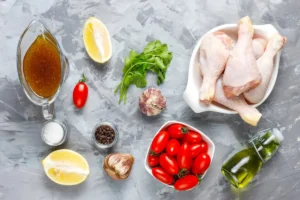Introduction to Chicken Sausages
In today’s culinary landscape, chicken sausages stand out as a versatile and health-conscious choice for meat lovers everywhere. Whether you’re flipping through a gourmet magazine or browsing the aisles of your local grocery store, the popularity of these sausages is undeniable. But what exactly goes into these delectable links? This article peels back the casing to reveal the ingredients, nutritional value, and varieties of chicken sausages, offering insights into their manufacturing process and even tossing in some scrumptious cooking tips. So, buckle up, folks! We’re about to embark on a flavorful journey into the world of chicken sausages.
Introduction to Chicken Sausages
What Are Chicken Sausages?
They are a delightful twist on traditional sausage varieties, swapping out beef or pork for chicken. This swap not only lightens the dish in terms of fat content but also brings a unique taste to the table. It’s no wonder they’ve become a go-to for health-conscious eaters and culinary adventurers alike.
Popularity and Health Benefits
The rise in popularity of chicken sausages can be attributed to a growing awareness around healthier eating habits. Compared to their pork counterparts, they boast a lower fat content and fewer calories, making them an attractive option for those looking to maintain a balanced diet without sacrificing flavor.
But the benefits don’t stop there. These sausages are also packed with high-quality protein, essential nutrients, and vitamins, contributing to muscle growth and overall health. Plus, with various flavors and spices added to the mix, chicken sausages offer a culinary versatility that’s hard to beat.
So, whether you’re grilling up a storm for a backyard barbecue or seeking a tasty protein for your next breakfast scramble, chicken sausages are sure to satisfy. Stay tuned as we dive deeper into the ingredients that make up these succulent links, explore their nutritional landscape, and share mouth-watering recipes to elevate your next meal.
Ingredients of Chicken Sausages

Chicken Meat: Types and Preparation
At the heart of every chicken sausage is, unsurprisingly, chicken meat. But not just any part of the chicken makes the cut. Manufacturers often use a blend of dark and white meat to strike the perfect balance between flavor and leanness. Dark meat, taken from thighs and drumsticks, lends the sausages a juicy richness, while white meat from the breast ensures the sausages remain lower in fat.
Before being ground into the base for sausages, the chicken undergoes a meticulous preparation process. It’s trimmed of excess fat and any undesirable parts to ensure the final product is of the highest quality. This careful selection and preparation process highlights the dedication to both health and taste that defines chicken sausages.
Spices and Seasonings
What truly sets one chicken sausage apart from another is its blend of spices and seasonings. From the smoky sweetness of paprika to the warm, earthy notes of sage, these ingredients are key to creating the sausage’s distinctive flavor profile. Garlic, onion, and a pinch of salt are also common additions, providing a depth of flavor that makes each bite more memorable than the last.
For those with adventurous palates, manufacturers might incorporate more exotic spices, such as fennel or cayenne pepper, to introduce an element of surprise. These seasonings not only enrich the taste but also contribute to the overall sensory experience of enjoying chicken sausages.
Natural vs. Synthetic Casings
Encasing the seasoned chicken mixture is a crucial step in sausage-making. The choice between natural and synthetic casings can influence both the texture and the culinary experience. Animals’ intestines, used to make natural casings, provide a traditional bite and are often favored because they can impart a slight, distinct flavor.
Synthetic casings, on the other hand, are designed for consistency and ease of production. Made from collagen, cellulose, or even plastic (removed before eating), these casings cater to a variety of dietary preferences and manufacturing requirements. Regardless of the type, the casing’s role in shaping and preserving the sausage’s integrity is undeniable.
As we’ve peeled back the layers on what goes into chicken sausages, it’s clear that a blend of quality ingredients and thoughtful preparation lies at the core of their appeal. Next, we’ll delve into the fascinating process of how these ingredients are transformed into the sausages we love, from grinding and mixing to cooking and packaging. Stay tuned for a behind-the-scenes look at the manufacturing process of chicken sausages.
Manufacturing Process

Grinding and Mixing
The journey from simple ingredients to succulent chicken sausages begins with the grinding and mixing phase. Here, the selected cuts of chicken are ground to a specific coarseness, depending on the desired texture of the final product. This ground chicken then enters a mixer, where spices and seasonings are added, blending everything into a homogeneous mixture. It’s during this step that the flavors begin to meld, setting the stage for a tasty outcome.
Stuffing and Shaping
Once the mixture reaches the right consistency, it’s time for stuffing and shaping. The ground chicken is carefully fed into casings using a sausage stuffer, a machine that ensures each sausage is evenly filled. This step requires precision, as the filling must be firm enough to hold its shape, yet not so dense that it affects the sausage’s texture. After stuffing, the sausages are twisted or tied at intervals to create individual links, a process that demands both skill and patience.
Cooking and Packaging
The final step in the manufacturing process is cooking and packaging. You can choose the ones that are fully cooked, partially cooked, or left raw, depending on your intended use and preference. Manufacturers heat fully cooked sausages to a safe internal temperature and then rapidly cool them to preserve freshness. Meanwhile, they prepare partially cooked or raw sausages for you to cook at home, providing a more hands-on culinary experience.
Once cooked to perfection, the sausages are packaged under strict hygienic conditions. Packaging not only protects the sausages from contamination but also extends their shelf life, ensuring they remain fresh from the factory to your fridge. With the packaging sealed, chicken sausages are ready to be shipped out and make their way onto store shelves and into your meals.
The manufacturing process of chicken sausages is a testament to the careful craftsmanship that goes into creating these delicious links. From the initial grinding and mixing to the final cooking and packaging, each step is performed with an eye for quality and a taste for excellence. Next, we’ll explore the nutritional value of chicken sausages, shedding light on their health benefits and how they fit into a balanced diet.
Nutritional Value
Calories and Protein Content
Chicken sausages are celebrated for their lean profile, offering a nutritious alternative to traditional sausages. With fewer calories than their pork or beef counterparts, they make an excellent choice for those managing their calorie intake. Moreover, they are a fantastic source of protein, providing the building blocks necessary for muscle repair and growth. This high-protein content, coupled with lower fat levels, makes chicken sausages an ideal component of a health-conscious diet.
Fat and Carbohydrates
One of the most appealing aspects of chicken sausages is their reduced fat content, particularly saturated fat, which is linked to heart disease. By choosing chicken sausages over more traditional options, individuals can enjoy a hearty meal without the added health risks. Additionally, these sausages typically contain minimal carbohydrates, making them suitable for low-carb and ketogenic diets. This balance of nutrients supports not only weight management but also overall wellness.
Vitamins and Minerals
Beyond macronutrients, chicken sausages are a source of essential vitamins and minerals. They are rich in B vitamins, particularly niacin (B3) and vitamin B6, which play critical roles in energy production and brain health. Furthermore, they offer minerals such as selenium and phosphorus, crucial for thyroid function and bone health, respectively. The nutritional composition of chicken sausages supports not just physical health but also cognitive functioning, underscoring their value in a balanced diet.
The nutritional value of chicken sausages positions them as a smart choice for anyone looking to enjoy the flavors of sausage without compromising their health goals. With a careful balance of protein, fats, and essential nutrients, these sausages can be a delightful addition to a variety of meals.
As we delve deeper into the world of chicken sausages, our next segment will introduce the varieties and flavors available, showcasing the versatility that has made them a favored option in kitchens around the globe. From breakfast sausages to Italian-inspired varieties, the range of chicken sausages caters to every taste and occasion.
Varieties and Flavors

Different Types and Flavors of Chicken Sausages
The world of chicken sausages is as diverse as it is delicious, offering a plethora of types and flavors to suit any palate. This diversity not only highlights the versatility of chicken as a base ingredient but also reflects the creativity of sausage makers in crafting unique taste experiences.
Breakfast Sausages
Starting the day right with a nutritious and flavorful breakfast sets the tone for what’s to come. Breakfast sausages made from chicken provide a lighter alternative to their pork counterparts, without skimping on flavor. Seasoned with a blend of sage, thyme, and a hint of maple, these sausages can transform any morning meal into a feast. Pair them with eggs and whole-grain toast for a balanced and satisfying start to your day.
Italian Chicken Sausages
For those craving the robust flavors of Italy, Italian chicken sausages are a must-try. Infused with fennel, garlic, and red pepper flakes, these sausages are a testament to the rich culinary traditions of Italy. Perfect for grilling or slicing into pasta dishes, they offer a taste of the Mediterranean without leaving your kitchen.
Specialty and Gourmet Varieties
The innovation doesn’t stop there. The market is also home to specialty and gourmet varieties that incorporate unexpected ingredients like apple, spinach, and even cheese. These combinations might sound unusual at first, but they’re meticulously crafted to deliver a harmonious and delectable flavor profile. Whether you’re looking to elevate a simple dish or experiment with new flavors, these gourmet chicken sausages are sure to inspire your culinary adventures.
The array of chicken sausage types and flavors available today is a testament to their growing popularity and the endless possibilities they offer to both home cooks and professional chefs. With options ranging from traditional breakfast sausages to inventive gourmet creations, there’s a chicken sausage to delight every diner.
In our next segment, we’ll move from the butcher’s shop to the kitchen, sharing cooking tips and delicious recipes that showcase the best ways to prepare and enjoy chicken sausages. Whether you’re a seasoned cook or just starting out, these insights will help you make the most of this versatile ingredient.
Cooking and Recipes
Cooking Tips and Delicious Recipes Using Chicken Sausages
Chicken sausages are not only nutritious and flavorful but also incredibly versatile in the kitchen. With the right cooking techniques and some inspired recipes, these sausages can become the star of any meal. Here, we’ll explore some essential tips for cooking chicken sausages and share recipes that are sure to impress.
Grilling and Pan-Frying
For those perfect, slightly crisp edges and a juicy interior, grilling and pan-frying are your go-to methods. When grilling, ensure your sausages are at room temperature before they hit the grill to promote even cooking. Medium heat works best, allowing the sausages to cook through without burning the exterior. If you’re pan-frying, a dash of olive oil in a non-stick pan over medium heat will do the trick. Remember, turning them occasionally is key to achieving that golden-brown perfection all around.
Recipe Ideas
- Chicken Sausage and Peppers Skillet – A simple yet vibrant dish, this skillet recipe involves sautéing sliced chicken sausages with bell peppers, onions, and a splash of balsamic vinegar. Serve it over steamed rice or tucked into a warm crusty roll for a satisfying meal.
- Spinach and Chicken Sausage Pasta – For a quick and hearty dinner, toss cooked pasta with sliced chicken sausages, fresh spinach, cherry tomatoes, and a generous drizzle of garlic-infused olive oil. Finish with grated Parmesan for a dish that’s both comforting and elegant.
- Chicken Sausage Breakfast Burritos – Kickstart your morning with a protein-packed breakfast burrito. Fill a whole wheat tortilla with scrambled eggs, diced chicken sausage, black beans, avocado, and shredded cheese. A dollop of salsa and some fresh cilantro will bring this breakfast to life.
These recipes showcase the adaptability of chicken sausages, proving they can be the centerpiece of meals from dawn till dusk. By incorporating them into different dishes, you can enjoy their delightful flavor and nutritional benefits in a multitude of ways.
As we wrap up our culinary journey through the world of chicken sausages, we’ve explored their ingredients, manufacturing process, nutritional value, and the vast array of flavors available. We’ve also shared some cooking tips and recipes to inspire your next meal. Chicken sausages offer a delicious and healthful alternative that doesn’t skimp on flavor, making them a worthy addition to any diet.
Stay tuned for our final segment, where we’ll address some Frequently Asked Questions about chicken sausages. Whether you’re curious about their shelf life or wondering if they can be eaten raw, we’ve got the answers to your burning questions.
Frequently Asked Questions
Are chicken sausages healthier than pork sausages?
Yes, chicken sausages tend to be healthier than pork sausages due to their lower fat and calorie content. They are an excellent source of lean protein, making them a preferable choice for those looking to maintain a balanced diet without giving up the savory satisfaction of sausages.
Can chicken sausages be eaten raw?
No, chicken sausages should not be eaten raw. Like all poultry products, they need to be cooked to an internal temperature of 165°F (74°C) to ensure they are safe to eat. This precaution eliminates the risk of foodborne illnesses associated with raw poultry.
How long do chicken sausages last in the fridge?
Uncooked chicken sausages last 1-2 days in the fridge. Cooked ones stay fresh for 3-4 days. For longer storage, freeze them. Uncooked sausages keep for up to 2 months frozen. Cooked varieties last up to 3 months. Use airtight containers or freezer bags for quality.
We’ve explored what makes them great. From selecting ingredients to the art of making them, and how to enjoy them, they are a versatile, healthy choice.
Our FAQ section aims to clear doubts and boost confidence in using chicken sausages. They’re a lighter alternative to traditional meats, offering new flavors.
Remember, great meals come from the care and creativity in preparation. Next time you shop, try chicken sausages for a new culinary adventure. Happy cooking!

